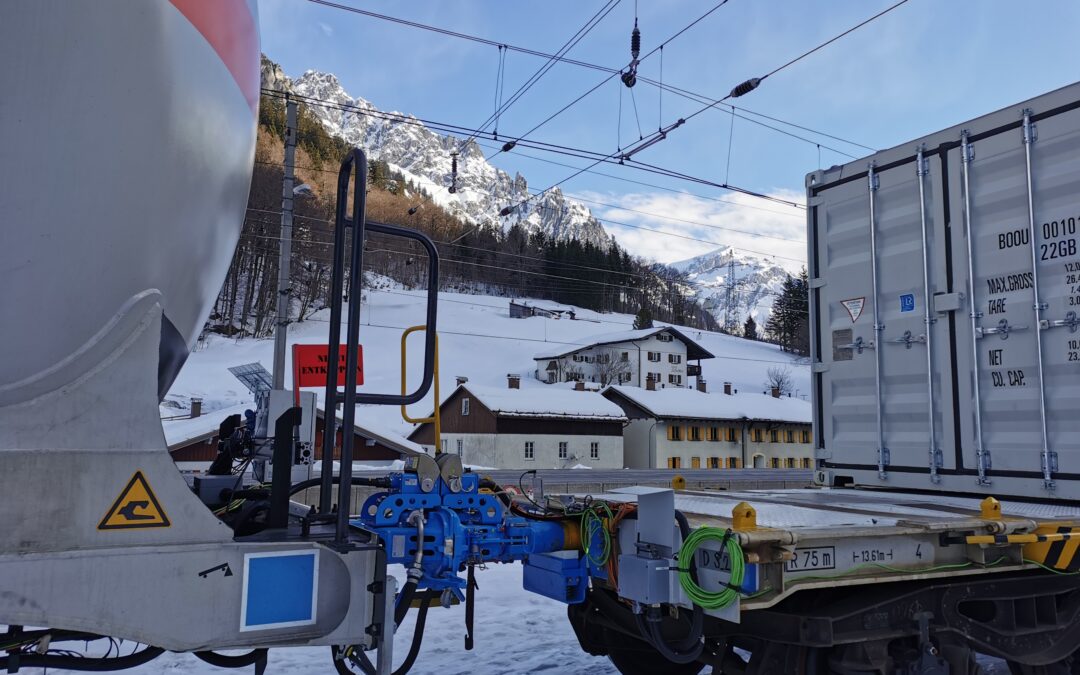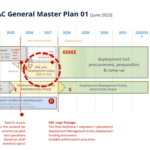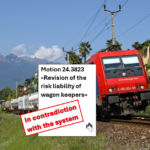In step with Europe and with substantial à fonds perdu financing, the migration to DAK will succeed. We at the VAP are joining forces with the BAV, VöV, partner companies and coordinated with European institutions to develop the project for the digitalisation and automation of Swiss rail freight transport. In this blog article we present a current overview.
This is what it’s all about:
- Why DAC migration is so important for Swiss rail freight.
- What realistic and fair financing must look like.
- How a smooth, cross-border migration of DAC can be achieved.
In Switzerland, the political discussion on the future of rail freight transport has been initiated. Until mid-February 2023, the federal government will consult on the question: how much freight transport by rail do we want in the future? A key element of this is the comprehensive modernisation of rail freight transport by means of a modern digital automatic coupling (DAC) – this is intended to comprehensively renew previous labour-intensive and time-consuming work processes in rail freight transport. Thanks to digitalisation and automation, rail freight transport should then become more efficient, more powerful and thus more competitive, and in future play a leading role in multimodal logistics. The innovation of rail freight transport is a European matter, as Switzerland is part of the interoperable European railway network. Transports should also continue to take place across borders without obstacles. This is why Swiss companies are actively involved in the EU’s Europe’s Rail innovation programme.
We would like to take this opportunity to give you an interim update on our current work and challenges.
General
The VAP is committed to very close coordination with the European project – European DAC Delivery Program (EDDP) of Europe’s Rail. Why?
European freight transport urgently needs comprehensive innovation to be able to survive in the highly competitive transport sector in the future or to be part of a modern supply chain – the DAC is the key project for this.
Most wagon fleets are used or rented out internationally and accordingly the migration must be coordinated across borders.
The technical specifications, which are defined at EU level, apply to all countries and must also be applied in Switzerland.
A common purchasing policy for the new couplings helps to reduce the unit price and one can fall back on uniform requirements.
The challenges – with a few exceptions – are identical in many countries. Regarding the migration timeline, there are major differences.
International coordination means optimal use / deployment of limited resources and experts.
In Switzerland, we are currently focusing on important preliminary work for the concretisation of the overall migration and also on the contents for the message, which will be the basis for the implementation of the migration.
Financing
VöV, VAP and SBB, as important representatives of the railway industry, agree that such a large investment for the DAC migration must be supported with appropriate financing tools and mechanisms.
There is agreement that a predominant “à fonds perdu” participation of the federal government and supplementary interest-free loans are necessary. Furthermore, the VAP in particular repeatedly pointed out the need for a clean cost-benefit balance. It ultimately found its way into the agreements on the DAC with the BAV. As is well known, the investments in the DAC migration are mainly incurred by the vehicle owners, while the benefits will only materialise much later after full implementation. On the one hand, it is therefore necessary to regulate the longer phase of pre-financing until the benefits begin to accrue. Above all, however, the benefits will be felt first and foremost by the railway undertakings (RUs) and the infrastructure managers (IMs). They will benefit from more efficient processes, whereas vehicle owners will see little benefit. The investment must be borne jointly by the actors in accordance with the potential benefits. In view of the market conditions, it will only be possible to a limited extent to generate this process through higher rental income. The financing concerns a time span of at least 15 years. Consequently, we suggested that the draft law should define appropriate mechanisms for joint financing according to the actual benefits that accrue, in a binding and fair manner for all parties involved, on the basis of “cost-benefit analyses”.
To this end, the VAP – together with the umbrella organisation of the UIP – will contribute data and facts on investment and cost/benefit planning and actively participate.
The concrete financing modalities within the EU are still open at present; solutions still have to be found in particular regarding the participation of the EU and the member states.
Engineering
For a successful and efficient implementation of the DAC migration, competent engineering is required, which defines the conversion measures for the specific fleet, provides the technical specifications for the orders and the conversion work, and defines the verification for quality assurance. In the coming months, the European EDDP programme will work together to develop the necessary foundations. On this basis, the prerequisites for the national DAC migration must be worked out.
Migration
Each country must carry out extensive preparatory work so that the information and basics are available at time X of effective implementation. Accordingly, the project deals with the following questions, among others:
Determination of workshop capacities
- Necessary “pop-up” workshops
- Necessary resources
Owner-specific planning of the conversion
- Vehicle type and fleet sizes
- Critical elements and possible solutions in cooperation with EDDP
- Owner-specific scheduling
Data and information pool
- Updating the vehicle register as a basis for funding
- Timely provision of information to individual actors / stakeholder groups
Material pool
- Procurement of components for DAC migration
- Planning of material quantities and delivery dates
- Coordination of material flows to the conversion workshops
- Ensuring support in operation (repair material)
Currently we see a focus on the locomotives to be converted, as these are primarily on national routes in the WLV and must be equipped with DAC trains at the start of operation.
In Switzerland, as is already the case with SBB-Cargo, further “pilot transports” will be planned as early as possible in order to be able to introduce the resulting findings and results at EU level and to be able to advance the project as a whole.
Organisation
On the one hand, the VAP has increased the resources in the General Secretariat, on the other hand it is represented with its members in various national and international meetings and working groups.
For the future or the effective implementation we see some challenges in the design and staffing of the overall organisation – be it in the international context (where is which aspect coordinated or also monitored) as well as in the cross-sectoral organisation of Swiss DAC migration.
Did you know that…
- …without DAC, no freight train – WLV, block train or Rola – will be able to run on fully equipped ETCS Level 3 (European Train Control System) lines in future, as the technical requirements, especially train integrity, are not met. The infrastructure upgrade to ETCS Level 3 will mainly take place on busy main lines and will enable an increase in capacity with the dynamic block. Allowing trains to continue to run without train integrity on sections of line operated in this way will involve a great deal of effort.
- …the DAC will be an important component for digital data exchange and sustainable logistics, in the sense of customers and the climate, can only be realised with the participation of all players. This is the reason why the VAP is in any case committed to the realisation of a data platform based on “MODIG”. With DAC we achieve an increase in efficiency of the entire “supply chain”.
- …DAC will allow the traditional WLV to be run more efficiently and will help to make it self-sustaining at the latest after the migration has been completed.
→ To learn more about the DAC programme, click on: https://rail-research.europa.eu/european-dac-delivery-programme/



